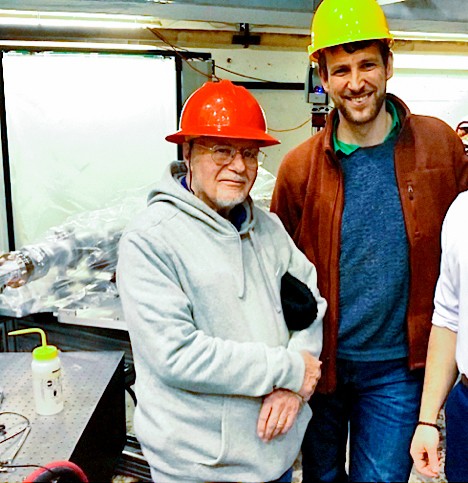
Representatives from Cornell, the Brookhaven National Laboratory and the New York State Energy Research Development Agency are shown during the CBETA test in February at Wilson Laboratory.
New accelerator sails through key test – recovering energy
By Rick Ryan
A half-century after the idea of energy-recovering accelerators was proposed at Cornell, the university is showing that high-energy physics can also be renewable-energy physics.
The Cornell-Brookhaven ERL Test Accelerator (CBETA) – an energy recovery linac (linear accelerator) research tool with applications in biology, chemistry and other disciplines – recovered nearly 99.8% of its own energy in its first key test June 24 at Cornell’s Wilson Laboratory.
“It is quite exciting that energy recovery has been reached,” said Georg Hoffstaetter, professor of physics and the CBETA project’s principal investigator. “Now we look forward to pushing CBETA further in its beam parameters.”
CBETA is testing two energy-saving technologies for accelerators – energy recovery and permanent magnets. An energy recovery linac (ERL) like CBETA reclaims the energy of a used electron beam instead of discarding it after an experiment.
The recovered energy is then used to accelerate the next beam of particles. The beams, used in many areas of research, are accelerated by superconducting radio frequency (SRF) units – another energy-efficient technology pioneered at Cornell.
By using permanent magnets instead of electromagnets, the power needed to steer the beam and cool the magnets is saved. While ERLs and permanent magnets are being used elsewhere, never before has a group built an accelerator where four particle beams – composed of different energies – concurrently by using fixed magnets through an ERL.
Hoffstaetter said Cornell has blazed a trail by using permanent magnets in a multi-beam ERL, bolstering the research capabilities of the energy recovery process. He emphasized it was his collaborators from Brookhaven National Lab, led by principal investigator Dejan Trbojevic, who designed and constructed these magnets.
The concept that energy recovery allows electron beams to be accelerated without using power from an external radio frequency source was first introduced at Cornell more than 50 years ago by physicist Maury Tigner, Ph.D. ’64, the Hans A. Bethe Professor Emeritus.
“Congratulations to the team, as I know that they have been working extremely hard to make energy recovery possible,” Tigner said after the June 24 test. “Now I am excited to see the potential of CBETA’s capabilities using this energy recovery.”
Since the 1960s, energy recovery has been accepted as a feasible way to operate a particle accelerator. However, this technology has not been easily adapted to routinely deliver a beam to a scientific experiment or for an industrial application – a goal for CBETA.
The immediate goal of CBETA is to serve as a reliable test ERL, particularly for the new Electron Ion Collider (EIC), for which Brookhaven National Lab is preparing a design report. The EIC has been determined by the National Academy of Sciences to be the nation’s highest-priority large accelerator for nuclear physics.
The high rate of collisions – the “luminosity” – needed for research at the EIC relies on the ability to “cool” (shrink the spread of) a particle beam, and only energy recovery linacs like CBETA can provide such cooling parameters.
While providing essential research and development for the EIC, the CBETA project has applications beyond EIC cooling and basic accelerator research. The team expects that CBETA will have an impact in industry, nuclear physics and X-ray science. “The first energy recovery at CBETA is an important step into these promising directions,” Hoffstaetter said.
Principal funding for CBETA comes from the New York State Energy Research and Development Authority.
Rick Ryan is a science communicator for CLASSE.
Media Contact
Get Cornell news delivered right to your inbox.
Subscribe

